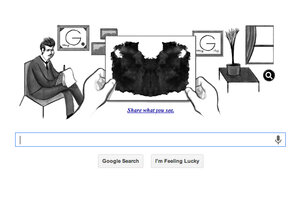Hermann Rorschach: Why his inkblot tests still endure
Hermann Rorschach, the pioneering psychiatrist, was born 129 years ago today.

The Google homepage today honors the psychiatrist Hermann Rorschach, who would have celebrated his 129th birthday today.
The Google homepage today depicts a dapper and mustachioed man, perched on a chair in his office, pen in hand. In the center of the doodle is a series of inkblot cards, which you can cycle through by clicking the small arrow icons. The images on the cards are deliberately ambiguous. Is that a pair of wings? A face? An ascendent airplane? But then again, as the pioneering psychiatrist Hermann Rorschach would have argued, that's the point.
In attempting to decipher each kaleidoscopic inkblot illustration, Mr. Rorschach believed, his patients could subliminally tell him a great deal about themselves.
Rorschach (not be confused with the popular "Watchmen" character of the same name, who wears an inkblot mask, in homage to the original Rorschach) was born on Nov. 8, 1884, and raised in Switzerland. According to the Encyclopedia Britannica, as a kid, young Rorschach was an avid sketcher, earning him the nickname "kleck," or inkblot.
After high school, Rorschach moved on to the Académie de Neuchâtel, where he studied geology and botany, before heading to the University of Zurich to study medicine. The Rorschach archives have him graduating from medical school in 1909 and signing on as a resident in the Thurgovian psychiatric hospital in Münsterlingen. In 1910, he married Olga Stempelin, a Russian medical student. Rorschach and Ms. Stempelin eventually had two children, a son and a daughter.
Rorschach's work with inkblot tests was promulgated in the early 1920s, with the publication of a book called Psychodiagnostik, or Psychodiagnostics.
"It might seem obvious (at least in these psychologically informed days) that a person who repeatedly sees people fighting in a series of inkblots might have a different mindset from someone who keeps on seeing people dancing, or people performing sexual acts," Randy Alfred of Wired has written. "Or that someone who always (or mostly) sees people would differ psychologically from someone who sees only birds, or mainly animals and rarely people, or someone persistently seeing inanimate objects rather than living things."
But at the time, the idea that inkblot tests could reveal important truths about a subject was a breakthrough. Unfortunately, Rorschach didn't live long enough to fully realize how influential his work would become. He died in 1922.
Over the ensuing years, his inkblot test was refined and refined again by other psychiatrists.
Today, of course, you don't necessarily need a professional psychiatrist to test out Rorschach's theories: all you need is a computer and an Internet connection and a few minutes of spare time to run through a few of the panels at theinkblot.com or theinkblottest.com.

